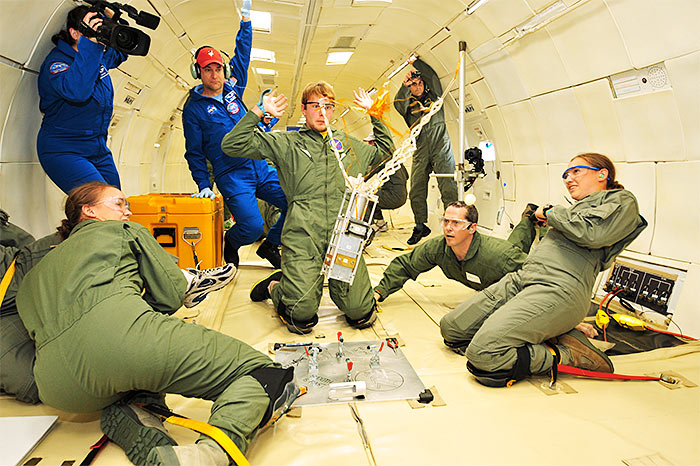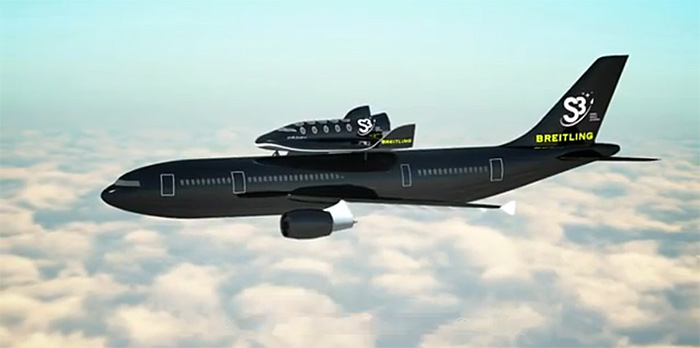
The market for microgravity aircraft flights appears to be in flux, with one company grounded, at least temporarily, while another prepares to enter the field.

The market for microgravity aircraft flights appears to be in flux, with one company grounded, at least temporarily, while another prepares to enter the field.
Swiss Space Systems has announced plans to offer microgravity aircraft flights in the United States, Canada, Europe, Asia, Japan, Ecuador, North Africa, and the Middle East, beginning in 2015.
Flights will make use of a modified Airbus aircraft. Customers will experience 15 parabolas, each providing between 20 and 25 seconds of weightlessness, during a 90-minute flight. Prices start at 2000 Euros (currently about $2800), with higher-price packages that include extras like a custom Breitling wristwatch.
The announced 2015 flight dates for North America are: Sept. 5-6 (Canada), Sept. 12-13 (Canada), Sept. 19-20, 2015 (Colorado), Sept. 26-27 (California), Oct. 3-4 (California), Oct. 10-26 (Florida), and Nov. 7-29 (Puerto Rico). Dates for other locations are available on the S3 ZeroG website.
Florida flights will operate from the former Space Shuttle runway at NASA’s Kennedy Space Center.
Swiss Space Systems has formed a new US subsidiary, S3 USA Operations (Florida) Inc. The company has signed a Memorandum of Understanding with Space Florida and leased offices at Space Florida’s Space Life Sciences Laboratory. S3 will also evaluate the Shuttle Landing Facility as a possible site for satellite launches beginning in 2018, using the proposed SOAR spaceplane.
Robert Feierbach, head of S3 USA, said, “S3 [will] offer research institutes and universities, partners or clients the possibility to conduct extremely precise and demanding missions in various microgravity environments. We will also let the public live this one-of-a-kind experience through our online ticketing system for our flight campaigns around the world.”
In the near term, S3 will compete directly with Zero G Corporation, which currently offers microgravity aircraft flights from Kennedy Space Center, Houston, Las Vegas, and other locations in the US. Zero G Corporation has a published fare of $4950 plus tax, although research flights are higher. Zero G corporation uses a Boeing 727 aircraft.

Swiss Space Systems (S3) has announced the establishment of a US subsidiary, S3 USA. The news follows last week’s announcement of a partnership between S3 and Spaceport Colorado, located at Front Range Airport just south of Denver.
S3, which is developing the SOAR spaceplane, currently has 50 employees in Switzerland. The suborbital SOAR spaceplane would be launched from the top of an Airbus A300 airliner at an altitude of 33,000 feet, reaching an apogee of 50 miles. The payload could be a pressurized module for microgravity experiments or an upper stage capable of placing a 550-pound satellite into orbit. A later version of the SOAR spaceplane could carry passengers on long-distance suborbital point-to-point flights.
The air-launch approach is similar to concepts proposed by Len Cormier and the US Air Force in the past.
Spaceport Colorado is a concept that’s been in development since August 2011. Front Range Airport is located just 40 minutes from downtown Denver and 18 minutes from Denver International Airport, currently the 11th busiest airport in the world. According to spaceport officials, “Colorado companies already conduct business with Europe in the morning, Asia in the evening and South America in the same business day. Future suborbital trips will reduce flight times to these destinations to a few hours.”
Front Range Airport started work on the FAA spaceport licensing application process in early 2012. The State of Colorado has supported the venture by passing a limited-liability spaceflight act, which received unanimous approval from both houses of the legislature and was signed into law by Governor Hickenlooper at the National Space Symposium in Colorado Springs on April 19, 2012.

Swiss Space Systems, which recently announced its plans to develop a small satellite launcher, has unveiled more ambitious plans.
Swiss Space Systems (S-3) recently announced its intent to develop a small satellite launcher. The S-3 launcher would comprise an unmanned spaceplane carried on the back of a zero-g-certified Airbus A300. The spaceplane would be launched from the A300 at an altitude of 10 kilometers (32,800 feet) and climb to an altitude of 80 kilometers (49 miles) on rocket power. At that point, it would deploy an upper stage and satellite before gliding back to its spaceport for landing, as shown in the following video.
[youtube=http://www.youtube.com/watch?v=_sLx6VH9EVU&w=700]
Swiss Space Systems, which is working with the French Aerospace firm Dassault and Belgian firms Sonaca and Space Application Services, will leverage work previously done for the European Space Agency’s Hermes spaceplane and NASA’s X-38 lifting body. The system is designed to launch satellites weighing up to 250 kg (550 pounds) at a price of 10 million Swiss Francs (about $10.5 million) per launch. The company hopes to bring the new launch system to operation by 2017 at a cost of 250 million Swiss Francs (about $260 million). It has already signed a contract with the Van Karman Institute for four launches.
Although unconventional, the idea of using a large airliner as a launch platform for a reusable spaceplane is not a new idea. In fact, the idea is more than 30 years old.